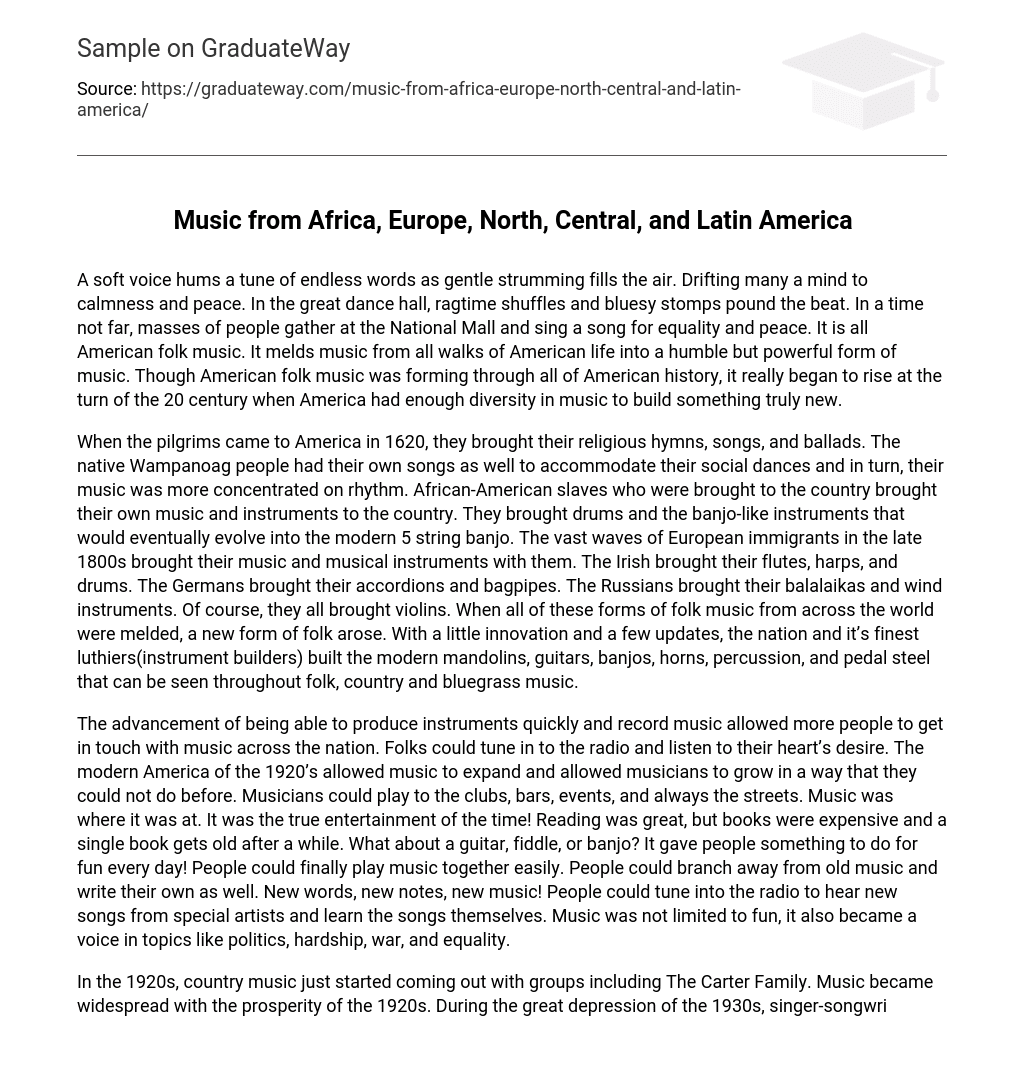A soft voice hums a tune of endless words as gentle strumming fills the air. Drifting many a mind to calmness and peace. In the great dance hall, ragtime shuffles and bluesy stomps pound the beat. In a time not far, masses of people gather at the National Mall and sing a song for equality and peace. It is all American folk music. It melds music from all walks of American life into a humble but powerful form of music. Though American folk music was forming through all of American history, it really began to rise at the turn of the 20 century when America had enough diversity in music to build something truly new.
When the pilgrims came to America in 1620, they brought their religious hymns, songs, and ballads. The native Wampanoag people had their own songs as well to accommodate their social dances and in turn, their music was more concentrated on rhythm. African-American slaves who were brought to the country brought their own music and instruments to the country. They brought drums and the banjo-like instruments that would eventually evolve into the modern 5 string banjo. The vast waves of European immigrants in the late 1800s brought their music and musical instruments with them. The Irish brought their flutes, harps, and drums. The Germans brought their accordions and bagpipes. The Russians brought their balalaikas and wind instruments. Of course, they all brought violins. When all of these forms of folk music from across the world were melded, a new form of folk arose. With a little innovation and a few updates, the nation and it’s finest luthiers(instrument builders) built the modern mandolins, guitars, banjos, horns, percussion, and pedal steel that can be seen throughout folk, country and bluegrass music.
The advancement of being able to produce instruments quickly and record music allowed more people to get in touch with music across the nation. Folks could tune in to the radio and listen to their heart’s desire. The modern America of the 1920’s allowed music to expand and allowed musicians to grow in a way that they could not do before. Musicians could play to the clubs, bars, events, and always the streets. Music was where it was at. It was the true entertainment of the time! Reading was great, but books were expensive and a single book gets old after a while. What about a guitar, fiddle, or banjo? It gave people something to do for fun every day! People could finally play music together easily. People could branch away from old music and write their own as well. New words, new notes, new music! People could tune into the radio to hear new songs from special artists and learn the songs themselves. Music was not limited to fun, it also became a voice in topics like politics, hardship, war, and equality.
In the 1920s, country music just started coming out with groups including The Carter Family. Music became widespread with the prosperity of the 1920s. During the great depression of the 1930s, singer-songwriters like Woody Guthrie wrote music that represented all the feelings of pain and despair of the time. Music became a refuge for the farmers who destroyed the land with their tills and wheat as what they had done had destroyed them too. It became a refuge for the factory workers being paid little to nothing in the smoggy cities. Music could be a cry for help or it could just be a way to help someone get their mind off something. Music was the only fun in the dusty world. The voices and songs of Woody Guthrie and Pete Seeger backed labor rallies and protest of the time.
After the Dirty Thirties and World War II, Pete Seeger continued protesting against the treason accusing methods of Joseph McCartney during the Red Scare and the Cold War. In the 1960s, the civil rights movement and the Vietnam War brought out many folk musicians with their pro-civil rights and anti-war songs. Famous musicians including Bob Dylan and Joan Beaz arose during this time of music. Pete Seeger’s “Where have all the flowers gone,” Bob Dylans “Blowing in the wind,” and the folk tune, “We Shall Overcome,” are all great examples of protest tunes from that time in history. The 1960s is known as the start of the great folk revival which brought bluegrass musicians and other folk musicians back into the music scene. Also, music and folk festivals gained popularity and became frequent throughout the country.
American folk music is different from other forms of folk because it evolved from many different styles of traditional music instead of just one or two. Music from Africa, Europe, North, Central, and Latin America are all ingredients in American folk music. It is a form of music that all people can connect to because it is connected to them. It is a type of music the can be played for fun, for freedom, for peace, and for love.





